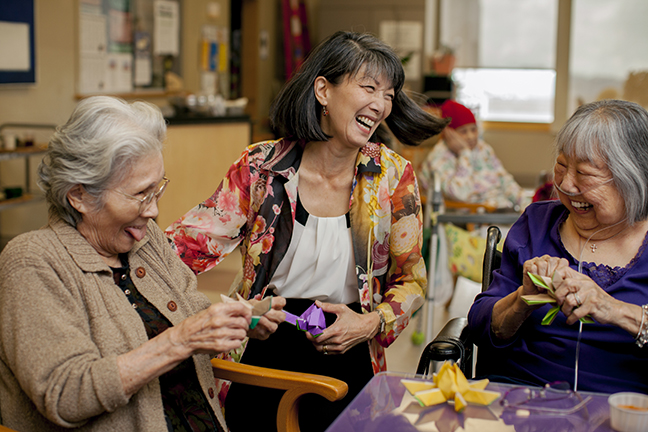Before my interview with Washington State Representative Sharon Tomiko Santos, I admit I wasn’t completely knowledgeable about the tragic history of the Japanese incarceration camps. I knew the incarceration was a great stain upon America. As a nation, we denied 120,000 people of Japanese heritage (the majority of them were citizens) their constitutional rights of due process and equal protection. Naively, I thought everything was neatly sorted out: reparations were made, the government officially apologized and the Supreme Court must have ruled it unconstitutional to incarcerate Japanese Americans without due process. However, as I dug deeper, I found that the story is far more complicated, especially the Supreme Court component.
Washington State Representative Sharon Tomiko Santos at her place of special meaning–Keiro Nursing Home, Seattle.
With the headlines of the legality of a Muslim registry and the Japanese internment camps cited as a precedent by Carl Higbie, a Trump surrogate during his presidential election campaign, I decided to reexamine Representative Santos’s interview in 2015, when she posed for her Power in Place portrait. Her maternal family (mother and grandparents) had been forcefully relocated to an incarceration camp in 1942. As a child, Representative Santos grew up with the sense that a great injustice had been committed against her community. Sorting through her interview, I started to realize that this incredible woman was a witness to the post-incarceration rebuilding and healing of her community and the legal battles to follow. As she put it: “History unfolded and I happened to be there, like the Tom Hank’s movie Forrest Gump, where he's getting to be a witness throughout history. I was a Japanese American female Forrest Gump, in this case."
“History unfolded and I happened to be there, like the Tom Hank’s movie Forrest Gump, where he’s getting to be a witness throughout history. I was a Japanese American female Forrest Gump, in this case.”
A group of Japanese-Americans arrive at the Manzanar incarceration camp carrying their belongings in 1942.
As much as her parents shielded Sharon Tomiko from the family’s economic and psychological repercussions of incarceration, she grew up feeling the continued discrimination toward Seattle’s Japanese-Americans. “People in the community were very angry about being mistreated, not heard, effectively patted on the head and told to go away.” Combined with early civic engagement and a personal call to action, Sharon Tomiko was part of a larger community discussion "about how do we get a place at the table.” It first began as a fight for redress—obtaining an official governmental acknowledgment that a great injustice was perpetrated upon her fellow Japanese Americans by incarcerating them during World War II. "Seattle achieved renown for having organized the very first Day of Remembrance in the country. As a high school student, I was able to galvanize my fellow students to help organize and volunteer at the event. We were, collectively, as the organizing committee, very surprised at the overwhelming response we received from the greater Seattle area. We thought we would be lucky to have ten/twenty cars show up, but a caravan stretched several miles long from Seattle to Puyallup, which was the first assembly center where they assembled all the Japanese Americans,” for mass detention.
Later on in college, as a student of history and specifically governmental and constitutional history, Sharon Tomiko's senior project focused upon the coram nobis case of Gordan Hirabayashi.
Gordan Hirabayashi was one of only three Americans to defy the U.S. government's incarceration of Japanese-Americans during World War II.
"Since Gordon Hirabayashi is a Seattle person, his coram nobis case actually took place right downtown, in our federal courthouse. So as a college student, I was able to watch history unfold.”
Gordon Hirabayashi’s initial case was heard by the US Supreme Court in 1943. He had openly defied Roosevelt’s imposed wartime curfew upon Japanese Americans. His resistance challenged the very premise of the executive order of exclusion, as well as deportation and incarceration. At the time, the Supreme Court’s decision focused around a narrow legal interpretation of the necessity of allowing curfew policies if our national security is threatened during wartime.
In 1982, newly unearthed documents suggested that US government officials did indeed hide evidence that demonstrated there was no true military reason for Roosevelt’s exclusion order. Thereby, Japanese Americans were denied due process under US law when they were forcefully deported to camps.
“US Supreme Court never had the opportunity to rule on the constitutionality of the policy of Japanese American incarceration. Thus, technically, the wartime exclusion order still stands today. ”
Using a writ of coram nobis (a legal order allowing for a correction in judgment of court cases when new information surfaces that proves key evidence was concealed during the initial court proceedings), Hirabayashi’s case was reopened by US Court of Appeals for the 9th Circuit. In 1984, his conviction was subsequently overturned. As a result, his case never made it back to the US Supreme Court, thus the high court never had the opportunity to rule on the constitutionality of the policy of Japanese American incarceration. Thus, technically, the wartime exclusion order still stands today.
President Reagan signing the 1988 Civil Liberties Act.
Sharon Tomiko and her people’s fight for redress wasn’t in vain. To compensate the victims who suffered gross injustice and hardship caused by wartime incarceration, Congress passed the Civil Liberties Act in 1988 when she was in graduate school. It was a formal presidential apology to every surviving US citizen or legal resident immigrant of Japanese ancestry incarcerated during World War II. The Act also provided a provision for a public education fund to prevent a future recurrence of forced incarceration and the loss of one’s inalienable rights. Two governmental agencies were established to implement reparations payments to eligible individuals.
Representative Sharon Tomiko Santos never forgot the lessons of her community’s trials and tribulations. To this day, she remains a vocal advocate for her legislative district’s diverse population. In particular, she holds special regard for the elderly—“the immigrant Japanese pioneers who, with nothing more than just hopes, came to the United States, like so many other immigrants and found that there was opportunity here. But because of rampant racism and discrimination, the dreams for opportunities were really not theirs to be able to reach and achieve. These elderly pioneers managed to still work very hard on behalf of their children’s opportunity. Their resilience, the lessons that they imparted to their children, and ultimately to their grandchildren, is why I've been able to succeed, and become a voice for those who are under-represented. Most importantly, I try to serve as a reminder to my colleagues about the deep meaning of the Constitution and our obligation, not just by words, but by real actions to continue to hold its relevance for future generations.”
Thank you, Representative Sharon Tomiko Santos, for imparting your family’s historic and personal narrative to Power in Place. Your story isn’t a relic of the past. It is as relevant as it was in 1942 and 1988. I’m reminded to stay vigilant and never assume that civil liberties are unassailable or guaranteed by our courts and government. The suppressed history of transgression against freedom must always be unearthed and understood as a warning for future generations who believe in true democracy.
For further study & understanding the history of the Japanese American community and their World War II experiences, Rep. Santos highly recommends Densho: The Japanese American Legacy Project www.densho.org.









